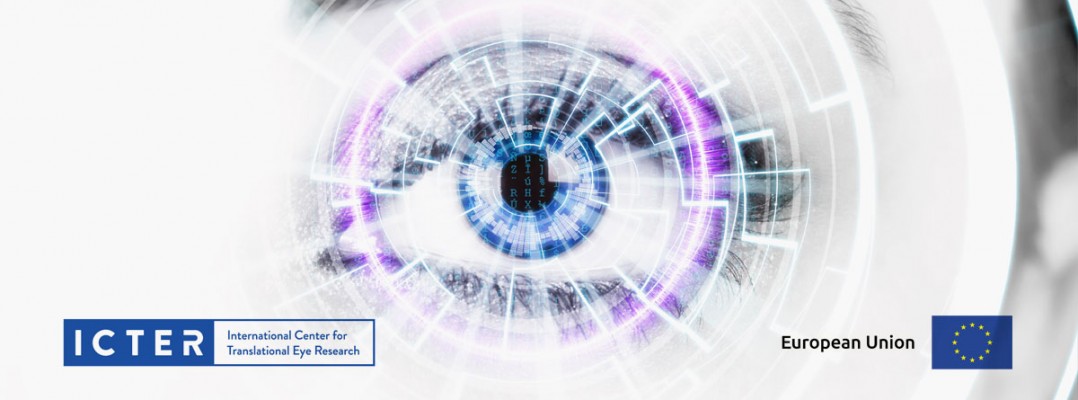International Centre for Translational Eye Research

ICTER General Overview
The International Centre for Translational Eye Research (ICTER) is a subunit of the Institute of Physical Chemistry, Polish Academy of Science. This Scientific Centre was established by Prof. Maciej Wojtkowski and Prof. Krzysztof Palczewski, awardees of the International Research Agendas (IRAP) program conducted by the Foundation for Polish Science.
ICTER’s strategic foreign partner is the Institute of Ophthalmology, University College London, in the United Kingdom. The Centre’s international scientific partner is the University of California Irvine, in the United States.
The main scientific priority of the International Center for Translational Eye Research (ICTER) is to enhance the understanding of the human eye - by researching into its dynamics and plasticity - in order to have a direct impact on new therapies and diagnostic tools.
At ICTER, there are five Research Groups:
- Physical Optics and Biophotonics Group (POB)
- Integrated Structural Biology Group (ISB)
- IImage-guided Devices for Ophthalmic Care Group (IDoc)
- Ophthalmic Biology Group (OBi)
- Computational Genomics Group (CGG)
Principal funding source
The International Centre for Translational Eye Research (MAB/2019/12) project is carried out within the International Research Agendas programme of the Foundation for Polish Science co-financed by the European Union under the European Regional Development Fund. The funding is guaranteed for 2019-2023 (54 months).
Research fields
Medical physics, Biochemistry, Instrumentation engineering, Pharmaceutical sciences, Optometry, Biomedical engineering.

Research groups
Physical Optics and Biophotonics Group (POB)
The research in our group can be seen as a perfect interplay between physics, biology and chemistry. We are focusing on developing imaging techniques and using them in many biological and chemical systems. Uniqueness of our approach is using not only amplitude of the light, but also its phase in order to develop new, top class imaging systems. Optical Coherence Tomography is the great example of such method (see movie below of long-range OCT volume of human eye). Furthermore, we are implementing the innovative method for imaging distortion removal ― STOC (Spatio Temporal Optical Coherence manipulation), that have a potential to largely increase the quality of imaging through opaque layers, such as skin.
- Principal Investigator and Group Leader: prof. Maciej Wojtkowski, mwojtkowski@ichf.edu.pl
- Lab Coordinator: dr Marzena Łazarczyk marzena.lazarczyk@ichf.edu.pl
Integrated Structural Biology Group (ISB)
Research at the Integrated Structural Biology (ISB) Group aims to elucidate the mechanisms of vision, particularly proteins of the phototransduction pathway and the visual cycle, at an atomic and molecular level, using structural biology techniques and other complementary biophysics characterization methods.
- Principal Investigator and Group Leader: dr Humberto Fernandes, hfernandes@ichf.edu.pl
- Lab Coordinator: dr Justyna Czarnecka justyna.czarnecka@ichf.edu.pl
Image-guided Devices for Ophthalmic Care Group (IDoc)
The Image-guided Devices for Ophthalmic Care (IDoc) laboratory seeks to research novel techniques and develop instrumentation to address unanswered questions in vision science and unmet needs in ophthalmology and optometry. The IDoc team members put their experience and know-how in optical engineering, imaging, biomedical physics, computing and mechatronics to work on translational eye research, by collaborating with vision scientists on one side and ophthalmologists, optometrists, and surgeons on the other.
- Principal Investigator and Group Leader: dr Karol Karnowski kkarnowski@ichf.edu.pl
- Lab Coordinator: Dominika Życka-Malesa d.zyckamalesa@ichf.edu.pl
Ophthalmic Biology Group (OBi)
OBi Lab utilizes the latest advancements in molecular biology, genetics, and viral tracing techniques to find new viral therapies for the restoration of visual signal processing in the diseased retina. We use in vivo and in vitro electrophysiology for investigating the system of local and distant communication between the different populations of neurons responsible for visual information processing, how the disease changes the functioning of the visual system, for testing the effects of therapy. We harness new technologies and programming strategies to support our efforts in vision restoration.
- Principal Investigator and Group Leader: dr Andrzej Foik, afoik@ichf.edu.pl
- Lab Coordinator: dr Anna Posłuszny, aposluszny@ichf.edu.pl
Computational Genomics Group (CGG)
The objective of the research at CGG is to leverage the latest single-cell multiomics methods to understand eye diseases. Research conducted at the CGG focuses on combining approaches from statistics, statistical physics, mathematics and computer science to develop new computational methods to handle the complexity of information and resolve biological processes from massive single-cell omics experiments.
- Principal Investigator and Group Leader: dr Marcin Tabaka, mtabaka@ichf.edu.pl
- Lab Coordinator: dr Lidia Wolińska-Nizioł lwolinska-niziol@ichf.edu.pl
Contact
International Centre for Translational Eye Research (ICTER)
Institute of Physical Chemistry, Polish Academy of Sciences
Headquarters / Optics & Engineering laboratories
Skierniewicka 10A
01-230 Warsaw
Biological & Chemical laboratories
Kasprzaka 44/52
01-224 Warsaw
Contact details
e-mail: icter@ichf.edu.pl
tel.: +48 607 293 453
Social media

